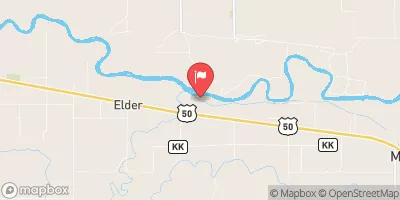Lake Meredith Reservoir Report
Nearby: Dye Ordway Town Res. Cell No. 2
Last Updated: January 2, 2026
Lake Meredith, located in Crowley County, Colorado, is a private reservoir primarily used for irrigation purposes.
°F
°F
mph
Wind
%
Humidity
Summary
Built in 1926, this earth dam structure stands at a height of 30 feet and has a storage capacity of 41,413 acre-feet. With a surface area of 6,223 acres and a drainage area of 115 square miles, the reservoir offers recreational opportunities and serves as a fish and wildlife pond in addition to its primary function for irrigation.
Despite its fair condition assessment and significant hazard potential, Lake Meredith is regulated and inspected by the Colorado Department of Water Resources. The dam lacks a spillway, but its maximum storage capacity of 41,413 acre-feet and normal storage of 39,804 acre-feet make it a crucial water resource in the region. The risk assessment for the dam is categorized as high, emphasizing the importance of effective risk management measures to ensure the safety and sustainability of this vital water infrastructure.
With its historical significance dating back to the 1920s and its continued role in supporting agriculture and wildlife in the area, Lake Meredith stands as a testament to the importance of water resource management in the face of climate challenges. As climate enthusiasts and water resource advocates, understanding the intricacies of this reservoir's design, purpose, and regulatory oversight is key to appreciating the critical role it plays in the local ecosystem and economy.
Dam Height |
30 |
Hydraulic Height |
30 |
Drainage Area |
115 |
Year Completed |
1926 |
Structural Height |
30 |
Nid Storage |
41413 |
Surface Area |
6223 |
River Or Stream |
BOB CREEK |
Dam Length |
100 |
Hazard Potential |
Significant |
Primary Dam Type |
Earth |
Nid Height |
30 |
Seasonal Comparison
Weather Forecast
Nearby Streamflow Levels
 Arkansas River At Catlin Dam
Arkansas River At Catlin Dam
|
-999cfs |
 Catlin Canal At Mile 0.1
Catlin Canal At Mile 0.1
|
0cfs |
 Timpas Creek At Mouth Near Swink
Timpas Creek At Mouth Near Swink
|
20cfs |
 Apishapa River Near Fowler
Apishapa River Near Fowler
|
7cfs |
 Crooked Arroyo Near Swink
Crooked Arroyo Near Swink
|
3cfs |
 Arkansas River At La Junta
Arkansas River At La Junta
|
107cfs |
Dam Data Reference
Condition Assessment
SatisfactoryNo existing or potential dam safety deficiencies are recognized. Acceptable performance is expected under all loading conditions (static, hydrologic, seismic) in accordance with the minimum applicable state or federal regulatory criteria or tolerable risk guidelines.
Fair
No existing dam safety deficiencies are recognized for normal operating conditions. Rare or extreme hydrologic and/or seismic events may result in a dam safety deficiency. Risk may be in the range to take further action. Note: Rare or extreme event is defined by the regulatory agency based on their minimum
Poor A dam safety deficiency is recognized for normal operating conditions which may realistically occur. Remedial action is necessary. POOR may also be used when uncertainties exist as to critical analysis parameters which identify a potential dam safety deficiency. Investigations and studies are necessary.
Unsatisfactory
A dam safety deficiency is recognized that requires immediate or emergency remedial action for problem resolution.
Not Rated
The dam has not been inspected, is not under state or federal jurisdiction, or has been inspected but, for whatever reason, has not been rated.
Not Available
Dams for which the condition assessment is restricted to approved government users.
Hazard Potential Classification
HighDams assigned the high hazard potential classification are those where failure or mis-operation will probably cause loss of human life.
Significant
Dams assigned the significant hazard potential classification are those dams where failure or mis-operation results in no probable loss of human life but can cause economic loss, environment damage, disruption of lifeline facilities, or impact other concerns. Significant hazard potential classification dams are often located in predominantly rural or agricultural areas but could be in areas with population and significant infrastructure.
Low
Dams assigned the low hazard potential classification are those where failure or mis-operation results in no probable loss of human life and low economic and/or environmental losses. Losses are principally limited to the owner's property.
Undetermined
Dams for which a downstream hazard potential has not been designated or is not provided.
Not Available
Dams for which the downstream hazard potential is restricted to approved government users.

 Lake Meredith
Lake Meredith
 Meredith Reservoir (Content)
Meredith Reservoir (Content)
 Anticline Lake
Anticline Lake
 Lake Henry
Lake Henry
 Holbrook Reservoir
Holbrook Reservoir
 Olney Springs
Olney Springs